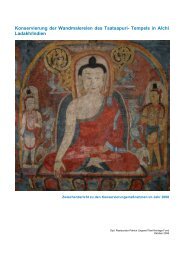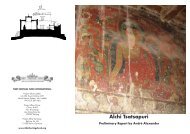Beijing Hutong Conservation Plan - Tibet Heritage Fund
Beijing Hutong Conservation Plan - Tibet Heritage Fund
Beijing Hutong Conservation Plan - Tibet Heritage Fund
You also want an ePaper? Increase the reach of your titles
YUMPU automatically turns print PDFs into web optimized ePapers that Google loves.
<strong>Hutong</strong><br />
A ‘<strong>Hutong</strong>’ is a narrow lane. The term is believed to be Mongolian in origin, since it first appears in <strong>Beijing</strong>’s<br />
Yuan dynasty records. There are several theories about the original meaning of the word, the most popular<br />
being that it means ‘water well’. Yuan dynasty city plans show 3 types of street, big streets (around 37.2m<br />
wide), small streets (18.6m wide) and <strong>Hutong</strong>s (9.3m wide). Big streets and Small streets mostly ran North-<br />
South, whilst the <strong>Hutong</strong> lanes, mostly ran West-East.<br />
<strong>Hutong</strong> lanes provide shelter from the wind and give a strong sense of privacy. Originally, many trees were<br />
planted in the courtyards, whilst more were planted later along the sides of the <strong>Hutong</strong> lanes. Maps from the<br />
Qing Dynasty and the Republican Era show that large numbers of important historic buildings, such as<br />
temples and monasteries (Buddhist, Taoist, Confucianist and local Deities) were once active throughout the<br />
<strong>Hutong</strong> areas. Many of these still exist today although many have been converted into housing.<br />
12<br />
Banchang <strong>Hutong</strong> facade<br />
Public Toilet Ruyi-men gate Jinzhu-men gate<br />
Xiao men lou gate Guangliang-men gate Local community office<br />
Pass by bar Western type gate Guangliang-men gate<br />
<strong>Hutong</strong> alley structure (Qianlong map)




